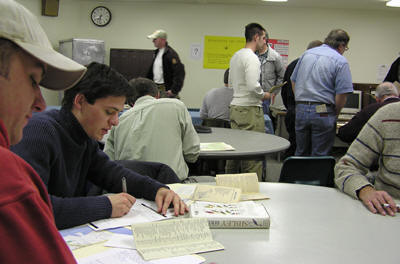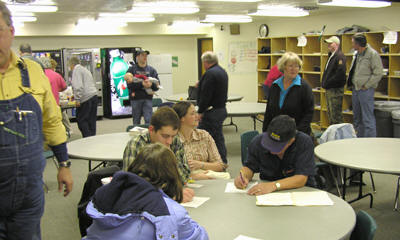Utah County Birders Newsletter
|
 |
|
Provo CBC Compilation/Potluck/Party - 17
December 2005 |
|
|
The 34th consecutive Provo CBC was on December 17 with six feeder watchers
and 37 observers in nineteen different parties looking for birds in the central
Utah locales of Provo, Orem and parts of Springville and Lindon. Eventhough the
temperature was quite cold (Utah Lake and Provo Bay were frozen solid), the
weather cooperated by being dry and windless.
Participants were able to tally 101 species (contrary to the 100 species
previously reported by an overly enthusiastic participant who neglected to
consider the possible results of the six feeder watchers whose results weren't
phoned in and added with the original totals until later in the evening after
the compilation was completed).
Starlings dominated the numbers with a total of 10,286 compared with 9462
reported last year. Seventeen species of waterfowl were tallied with the
highest being 3409 Mallards. Last year's total for Mallards was slightly higher
at 3731. Eleven species of raptors were counted with a high count for American
Kestrels of 81. Five species of owls were observed with two Northern Pygmy Owls
and one Saw-whet Owl seen up in Rock Canyon by two intrepid birders who spent
over six hours tromping in the snow. Two owling parties were able to account
for two other species, Gt. Horned Owl and four Western Screech Owls. Two Barn
Owls were observed in silos in west Orem during the day. House Sparrows, as
might be expected, were the second highest in terms of numbers with 1300 being
reported. This compares with 1749 reported for last year. Other species
with high numbers were: 1073 Rock Pigeons, 875 House Finches, 563 White-crowned
Sparrows, 534 Red-winged Blackbirds and 482 Black-billed Magpies. One of the
biggest decreases was in the number of American Crows which dropped from 841
last year to 119 this year. A Mew Gull was seen for the first time on the
count, and Least Sandpipers for only the second time. Cinnamon Teal and
White-throated Sparrow were other unusual species that were found this year.
It might be of interest to readers to look at the results over the last five
years. For the year 2000, 58 observers tallied 108 species; for 2001, 43
observers tallied 101 species; in 2003,47 observers counted 93 species; in 2003
41 observers counted 93 species; last year 41 observers counted 95 species and
this year, as already mentioned 37 observers tallied 101 species.
I would like to thank all those who participated. There were some new faces this
year, and some of you who have participated in the past were missed. Even so, we
were still able to cover all of the areas within the count circle. One hundred
forty-nine hours were expended by the 37 field observers who paid $5.00 each for
the privilege. Thanks again.
Merrill Webb
One morning while getting ready to leave for work I looked out my kitchen
window at the feeders to observe the goldfinches and the house sparrows
when I heard the little squeaks of a downy woodpecker. She was busy
pecking at the suet I had smeared into the cracks in the bark of my feeder
tree.
Suddenly all the finches and sparrows flew off to hide in the hedge along
the fence, but the downy froze and clung motionless on the house side of
the trunk. I checked the big tree on the other side of the feeder tree to
see the resident sharpie take his regular post high in the big tree. Lucky
for the downy, she was out of a clear shot for the sharpie and I thought
she would take her chance when the sharpie turned his back to the feeder
tree. But the downy did not move a muscle, shift her grip on the bark,
turn her head even slightly or blink an eye (maybe she sneaked a half of a
blink but I did not see it).
Five minutes went by and I had to turn away to make breakfast. Ten minutes
later I checked the scene and noticed that the sharpie had moved to a new
vantage point but the downy was still a statue. Now I was interested to
find out how long a woodpecker would cling to wood, or would she flee if
she could? (Is this how the tongue twister went?) At 25 minutes from the
opening of the scene nothing had changed. At 30 minutes, still clinging.
Same at 35 minutes. The sharpie had shifted positions three times, but the
downy was still faithful to her method of avoiding detection. Finally I
had to leave for work at 45 minutes, and took a last look out the window.
The downy was busy eating suet again in the same spot, the goldfinches had
returned and the sharpie had left, the obvious looser in the waiting game.
Let this be a lesson to us on the power of patience and perseverance and
sticking to the proven method of madness in this game of life and death
that we all are involved in.
~ Tuula Rose
We would like to hear your random observations. If
you have an observation to share send it to
Backyard Bird of the
Month
December 2005
Steve Carr - Holladay
All 3 Carduelins - 8-10 individuals of each species.
KC Childs - Provo
Green-tailed Towhee - first winter sighting.
Eric Huish - Pleasant Grove
Black-billed Magpies - Bullying and stealing the Sharp-shined Hawks meal.
Milt Moody - Provo
Sharp-shinned Hawk - I wondered where are my regulars went.
LeIla Ogden - Provo
American Goldfinch - Its about all I have in my yard.
Bruce Robinson - West Jordan
American Kestrel - On my TV antenna watching my feeders.
Tuula Rose - Provo
Mourning Dove - one still hanging around.
Mark Stackhouse - San Blas, Nayarit, Mexico
Collared Forest-Falcon - I hear it every afternoon across the estuary,
finally saw it sitting on a palm frond.
Reed Stone - Provo
Cedar Waxwings - A flock of feathered "rockets" feeding on fruit of a
Mountain Ash.
Bonnie Williams - Mapleton
Black-billed Magpie - The only one I've had this year.
We would like you to share your favorite backyard bird each
month. Please send your favorite bird at the end of the month to
newsletter@utahbirds.org or call 360-8777. If you would like a reminder at
the end of the month e-mail the above address.
